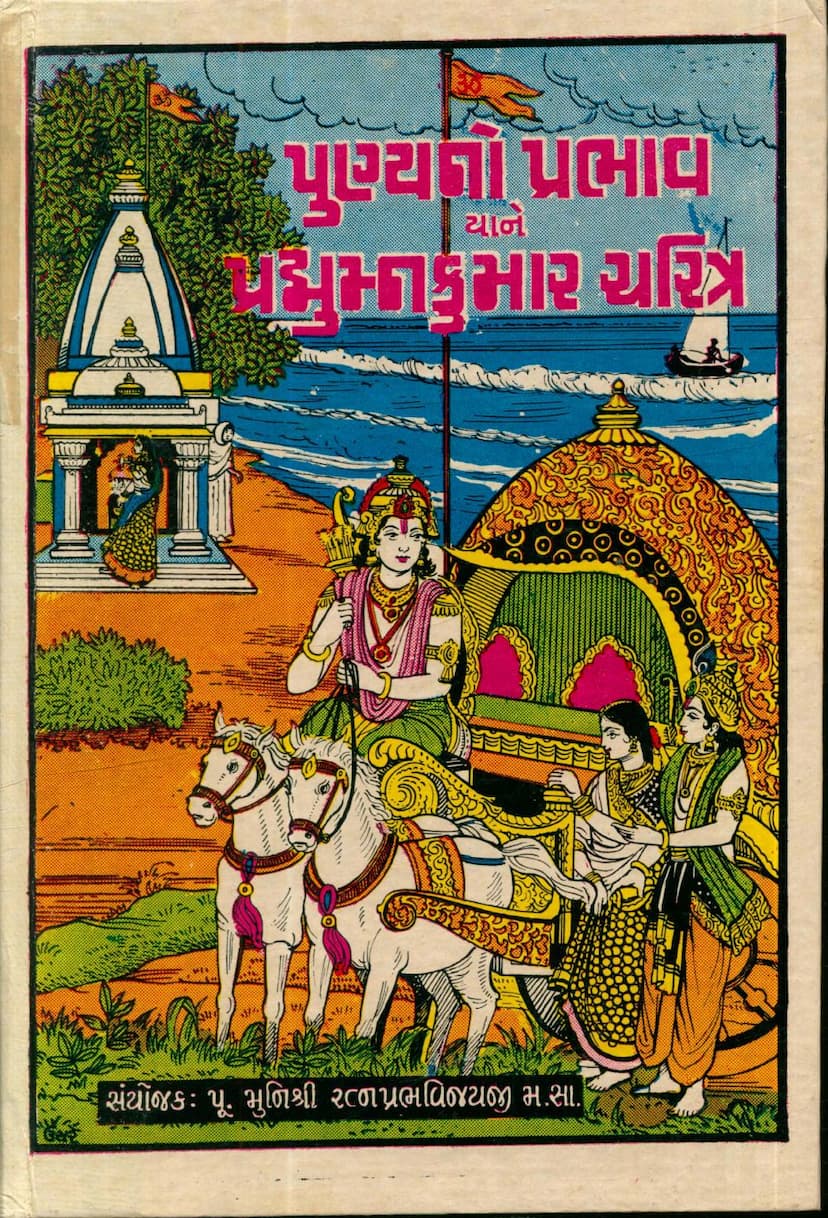Punyano Prabhav Yane Pradyumna Kumar Charitra
Added to library: September 2, 2025

Summary
This is a summary of the Jain text "Punyano Prabhav Yane Pradyumna Kumar Charitra" by Ratnaprabhvijay. The provided text is in Gujarati, and this summary is in English based on the content available.
The book, "Punyano Prabhav Yane Pradyumna Kumar Charitra" (The Influence of Merits, i.e., the Life Story of Pradyumna Kumar), authored by Ratnaprabhvijay and published by Shri Ratanchand Gulabchand Jain Upashray in Ahmedabad, narrates the life story of Pradyumna Kumar, the son of Lord Krishna and Rukmini. The narrative is presented as a discourse by Lord Mahavir Swami to King Shrenik, highlighting the importance of dharma (righteous conduct) and its role in achieving happiness and liberation.
Key Themes and Narrative Arcs:
- The Power of Karma and Merits (Punya): The title itself emphasizes the "influence of merits," suggesting that the events and outcomes in the characters' lives are driven by their past actions (karma) and accumulated merits (punya).
- Life of Pradyumna Kumar: The story details the life of Pradyumna Kumar, a significant figure in Jain and Hindu mythology. The narrative focuses on his birth, his divine and extraordinary qualities, and his spiritual journey.
- Divine Intervention and Celestial Beings: The text features the intervention of celestial beings like Narad Muni and various gods and demons, who play crucial roles in the unfolding of events. Narad Muni, in particular, appears to be a catalyst in many incidents, often sowing seeds of discord or guiding characters.
- Spiritual Guidance and Teachings: The teachings of Lord Mahavir Swami and later Lord Neminath serve as guiding principles throughout the narrative. The text underscores the importance of righteousness, detachment, and adherence to Jain principles for spiritual upliftment and ultimate liberation (moksha).
- The Story of Rukmini and Krishna: A significant portion of the narrative covers the events leading to Rukmini's marriage to Krishna, including the abduction and the ensuing conflict. Rukmini's beauty and virtue are highlighted, as is her devotion.
- The Journey of Pradyumna: The text elaborates on Pradyumna's early life, his spiritual development, his battles, and the acquisition of various "siddhis" (supernatural powers). The narrative seems to suggest that these powers are attained through dedicated spiritual practice and adherence to dharma.
- The Previous Lives (Purva Bhav): The text delves into the past lives of the characters, explaining the karmic reasons behind their present circumstances. This includes the story of how Pradyumna and his adversaries were connected through their past actions, demonstrating the cyclical nature of birth, death, and rebirth in Jain philosophy.
- The Consequences of Actions: The story illustrates the direct consequences of actions, both virtuous and otherwise. For instance, the pride of Satyabhama and the arrogance of the Brahman sons lead to their downfall or suffering, while devotion and righteous conduct lead to favorable outcomes.
- The Role of Women: The text portrays various female characters, including Rukmini, Satyabhama, and Jambavati, showcasing their devotion, their struggles with pride and jealousy, and their eventual spiritual growth. Rajimati's story, in particular, emphasizes her steadfastness in dharma despite adversity.
- The Renunciation of Lord Neminath: A significant part of the narrative is dedicated to the life and teachings of Lord Neminath, including his eventual renunciation of worldly pleasures and his path towards spiritual enlightenment. His interactions with Krishna and the influence of his teachings on Krishna's family are also depicted.
- The Destruction of Dwarka: The text describes the eventual downfall and destruction of Dwarka, attributed to moral decay and the consequences of past actions. This serves as a cautionary tale about the impermanence of worldly power and prosperity.
- The Ultimate Goal of Moksha: The underlying message throughout the narrative is the pursuit of moksha, or liberation from the cycle of birth and death, by adhering to the principles of dharma, non-violence, and self-control.
Key Characters and Their Journeys:
- Pradyumna Kumar: The central protagonist, whose life journey from birth to spiritual realization is chronicled. His strength, intellect, and adherence to dharma are central to his character.
- Lord Krishna: The father of Pradyumna, depicted as a powerful and virtuous ruler, though also shown to be influenced by worldly matters and relationships.
- Rukmini: Pradyumna's mother, known for her beauty, devotion, and steadfastness in her faith.
- Lord Neminath: A significant figure whose teachings and renunciation profoundly impact the characters, including Krishna and his family.
- Narad Muni: A recurring character who often acts as an instigator or messenger, influencing the events of the story.
- Satyabhama: A queen of Krishna, depicted as proud and jealous, highlighting the pitfalls of attachment and ego.
- Sambh (Shamb), Bhanukumar: Other sons of Krishna, whose lives and interactions with Pradyumna are part of the narrative.
- Jarasandha: An antagonist who seeks revenge against Krishna, leading to significant conflicts.
- Draupadi: Her pride and subsequent downfall serve as a lesson on the consequences of disrespect towards spiritual figures.
- Dvaipayan/Prajna: A character whose past actions lead to significant karmic consequences, demonstrating the law of karma.
- Gajasukumar: His story illustrates the power of spiritual dedication and the consequences of past actions.
The book aims to inspire readers to lead a virtuous life, understand the principles of Jainism, and ultimately strive for spiritual liberation. The narrative is rich with illustrative stories that convey profound moral and spiritual lessons.